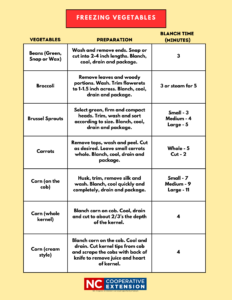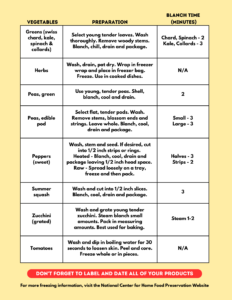Tips for Freezing the Harvest of the Summer
go.ncsu.edu/readext?947813
en Español / em Português
El inglés es el idioma de control de esta página. En la medida en que haya algún conflicto entre la traducción al inglés y la traducción, el inglés prevalece.
Al hacer clic en el enlace de traducción se activa un servicio de traducción gratuito para convertir la página al español. Al igual que con cualquier traducción por Internet, la conversión no es sensible al contexto y puede que no traduzca el texto en su significado original. NC State Extension no garantiza la exactitud del texto traducido. Por favor, tenga en cuenta que algunas aplicaciones y/o servicios pueden no funcionar como se espera cuando se traducen.
Português
Inglês é o idioma de controle desta página. Na medida que haja algum conflito entre o texto original em Inglês e a tradução, o Inglês prevalece.
Ao clicar no link de tradução, um serviço gratuito de tradução será ativado para converter a página para o Português. Como em qualquer tradução pela internet, a conversão não é sensivel ao contexto e pode não ocorrer a tradução para o significado orginal. O serviço de Extensão da Carolina do Norte (NC State Extension) não garante a exatidão do texto traduzido. Por favor, observe que algumas funções ou serviços podem não funcionar como esperado após a tradução.
English
English is the controlling language of this page. To the extent there is any conflict between the English text and the translation, English controls.
Clicking on the translation link activates a free translation service to convert the page to Spanish. As with any Internet translation, the conversion is not context-sensitive and may not translate the text to its original meaning. NC State Extension does not guarantee the accuracy of the translated text. Please note that some applications and/or services may not function as expected when translated.
Collapse ▲Freezing food is a quick and effective way to preserve food throughout the year. During this point in the summer, I’ve got more vegetables than I know what to do with. Canning is great but can be time consuming, so I often turn to freezing to ensure I am minimizing food waste and maximizing the bounty of the summer. In order to get the most out of your frozen food, consider some of the factors below.
Blanching
Blanching (scalding vegetables in boiling water or steam for a short time) is a must for almost all vegetables to be frozen. It stops enzyme actions which can cause loss of flavor, color and texture.
Blanching cleanses the surface of dirt and organisms, brightens the color and helps retard loss of vitamins. It also wilts or softens vegetables and makes them easier to pack.
Blanching time is crucial and varies with the vegetable and size. Underblanching stimulates the activity of enzymes and is worse than no blanching. Overblanching causes loss of flavor, color, vitamins and minerals. Follow recommended blanching times (pages 229-230).
Water Blanching
For home freezing, the most satisfactory way to heat all vegetables is in boiling water. Use a blancher which has a blanching basket and cover, or fit a wire basket into a large pot with a lid.
Use one gallon water per pound of prepared vegetables. Put the vegetable in a blanching basket and lower into vigorously boiling water. Place a lid on the blancher. The water should return to boiling within 1 minute, or you are using too much vegetable for the amount of boiling water. Start counting blanching time as soon as the water returns to a boil. Keep heat high for the time given in the directions for the vegetable you are freezing.
Cooling
As soon as blanching is complete, vegetables should be cooled quickly and thoroughly to stop the cooking process. To cool, plunge the basket of vegetables immediately into a large quantity of cold water, 60ºF or below. Change water frequently or use cold running water or ice water. If ice is used, about one pound of ice for each pound of vegetable is needed. Cooling vegetables should take the same amount of time as blanching.
Drain vegetables thoroughly after cooling. Extra moisture can cause a loss of quality when vegetables are frozen.
Storage Times
Freezing cannot improve the flavor or texture of any food, but when properly done it can preserve most of the quality of the fresh product. Knowing how long a particular food can be stored in the freezer is not as simple as it sounds.
The storage times listed below are approximate months of storage for some food products assuming the food has been prepared and packaged correctly and stored in the freezer at or below 0°F. For best quality use the shorter storage times. After these times, the food should still be safe, just lower in quality.
| Food | Approximate months of storage at 0°F |
|---|---|
| Fruits and Vegetables | 8 – 12 |
| Poultry | 6 – 9 |
| Fish | 3 – 6 |
| Ground Meat | 3 – 4 |
| Cured or Processed Meat | 1 – 2 |
Several factors influence the shelf life of frozen food besides the type of food.
Was the food properly blanched?
- Blanching is scalding vegetables in boiling water or steam for a short time.
- Blanching stops enzyme actions which cause loss of flavor, color, texture and nutrients even in frozen storage.
- Always follow recommended blanching times.
Was the food packaged in appropriate materials?
- Cool all foods and syrups before packaging to speed up the rate of freezing and help retain the natural color, flavor, and texture of the food.
- Packaging materials must be moisture-vapor resistant; durable and leak proof; protect foods from off-flavors and odors; and easy to seal.
- Good packaging choices for freezing foods include rigid containers made of plastic, glass or aluminum; semi-rigid aluminum foil pans; plastic bags; and flexible wraps including plastic, foil and laminated paper. For best moisture-vapor resistance, be sure to choose bags, wraps and boxes made especially for food freezing.
- Allow enough headspace so food can expand without breaking package seals.
- Label each package; include the name of the product, any added ingredients, packaging date, the number of servings of amount, and form of food.
- Use freezer tape, or pens and labels made especially for freezer use.
Was the food stored at an acceptable temperature?
- Freeze and store food at 0°F or lower for the best quality.
- Freeze foods as soon as they are packed and sealed.
- Do not overload the freezer with unfrozen food.
- Leave space among new, warm packages so the cold air can circulate freely around them. When the food is frozen, stack and store the packages close together if desired.
A good policy to remember and follow is “first in, first out”. Rotate foods so that you use the older items first and enjoy your food at its best quality.
I’ve made this Freezing Vegetables Chart to remind myself of the right blanching times for different vegetables. Print it out to keep on your kitchen for summer days when the vegetables and overflowing and you’re ready to put some away in the freezer. Happy Preserving!






